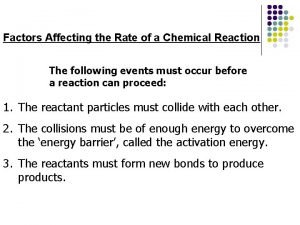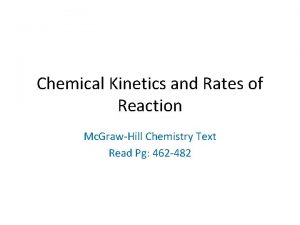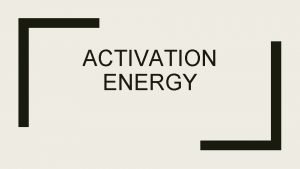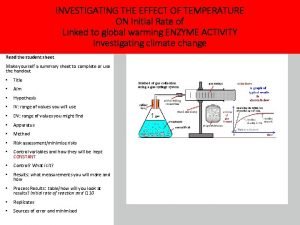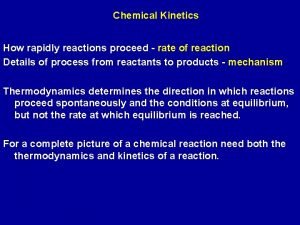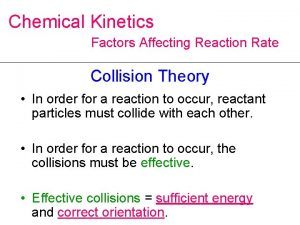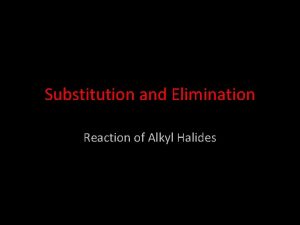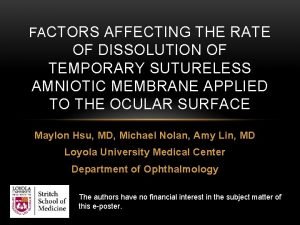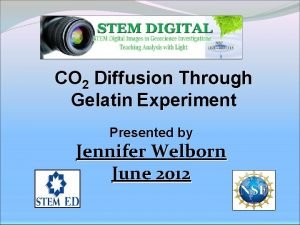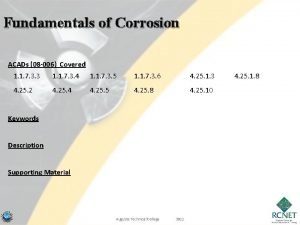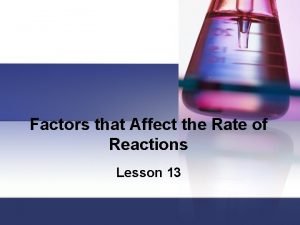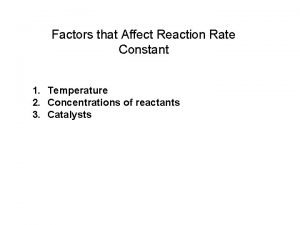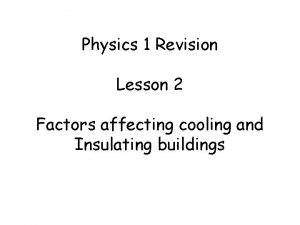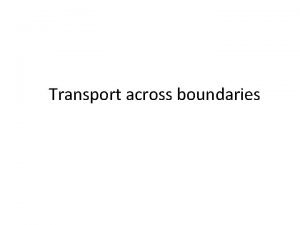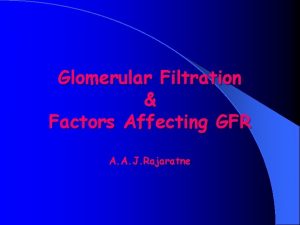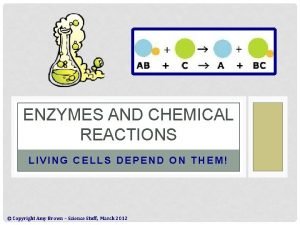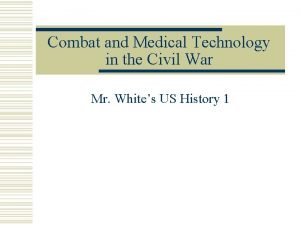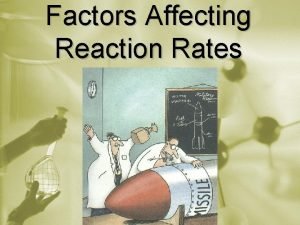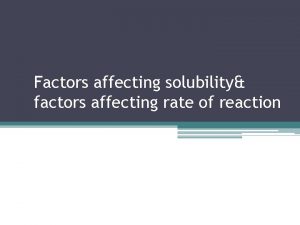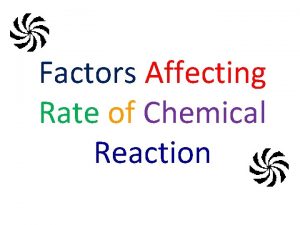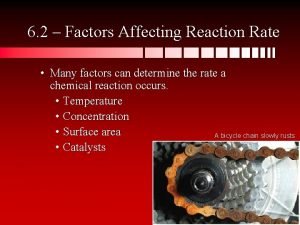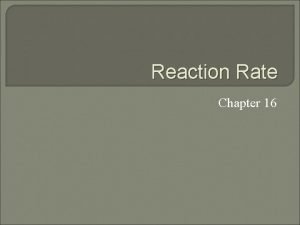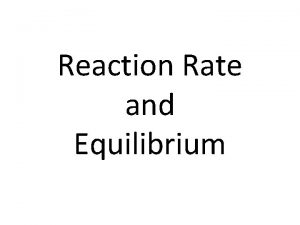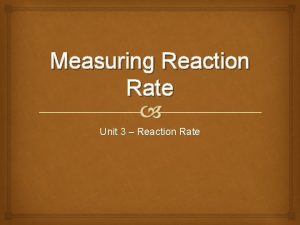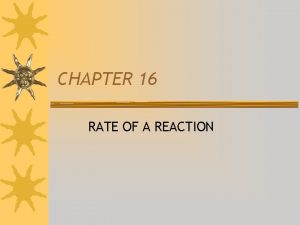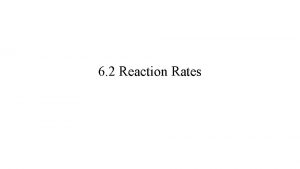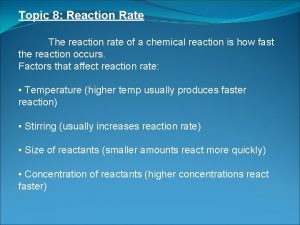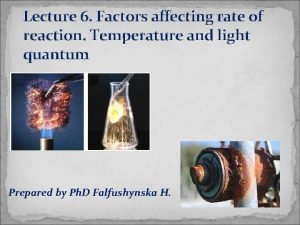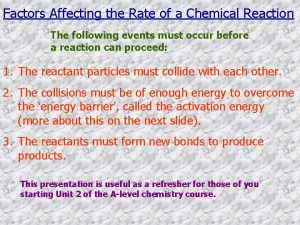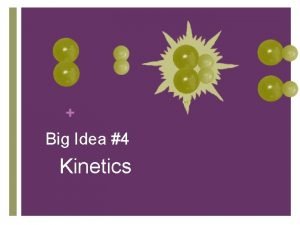Factors Affecting Reaction Rate Why Many factors affect




















- Slides: 20

Factors Affecting Reaction Rate

Why? Many factors affect the rate of chemical reaction. In fact, some factors are so important that reactions don’t appear to happen at all because they are so slow without proper conditions! These conditions include: Temperature 2. Concentration of the reactants 3. Surface Area 4. Presence of a catalyst (or inhibitor) 1.

1. Temperature is a measure of the average energy of molecules. • The more energy molecules have, the higher the temperature. • When molecules have more energy, they move around more, bump into other molecules more, and therefore react faster.

More on Temperature… • The rate of reaction changes with the temperature. • Higher temperature = faster reaction rate, and vice versa. • Sometimes we want slower reactions (we use a fridge to prevent spoilage). • Sometimes we want faster reactions (we cook food to speed up the production of new molecules).

Can you see that the molecules are actually moving faster with increased temperature? http: //id. mind. net/~zona/mstm/physics/mechanics/energy/he at. And. Temperature/gas. Molecule. Motion. ht ml

Example: Temperature and Reaction Rate �If a “glow stick” is placed in warm water it will glow brighter than one placed in ice water �This is because the “chemiluminescent” reaction occurs faster at a higher temperature making it glow brighter! Note: This is why on a hot day “glow stick” will appear brighter, but not last as long, as compared to a cooler evening

2. Concentration refers to how many molecules of a substance exist in a certain volume. • How much solute (what’s dissolved) is there in a certain amount of solvent (what the substance is dissolved in) • Concentration is measured in mass per unit volume (g/L) Usually, the higher the concentration of reactants, the faster the reaction occurs. • Since there are molecules per unit volume in high concentrations, there are more opportunities for molecules to collide and react.

Concentration continued… SO… The higher the concentration = the faster the reaction occurs The lower the concentration = the slower the reaction occurs Fast! Slow… High Concentration Low Concentration

Example: Concentration and Reaction Rate �A splint of wood glows brighter in highly concentrated oxygen than in normal air, with a lower concentration of oxygen. Changing the concentration of O 2 changes the intensity of flames.

3. Surface Area Chemical reactions occur when and where atoms and compounds collide. • The more atoms and molecules there are to collide, the higher the reaction rate. Increasing surface area increases the rate of reaction. • Since there are more atoms and compounds exposed to react, more reaction takes place.

More on Surface Area… • Surface area can be increased by creating smaller pieces. • A powdered substance has far more surface area than one, large chunk. • The increase in surface area must also be exposed for reaction—a powder only reacts more quickly if it is spread into the air instead of lying on a pan.

Greater Surface Area = Fast Smaller surface area = Slow… Fast!

Example: Surface Area and Reaction Rate �When steel is subjected to a sufficiently hot flame it can reacts with oxygen. �When steel wool (seen on the left) is used it has a much greater surface area than with shards (seen on the right) and therefore reacts much more vigorously

4. Catalysts Sometimes increasing the temperature or concentration is not a desirable method to increase reaction rate. • Changing these two variables may be impractical or dangerous. A catalyst is a chemical that allows a reaction to occur more quickly without actually participating in the reaction itself. • The catalyst speeds up the reaction rate, but does not get used up as a reactant. • Catalysts often lower the amount of energy necessary to break the bonds in the reactants.

Example 1: Biological Catalysts and Reaction Rate �Enzymes are an example of biological catalysts �Saliva has enzymes that help speed the breakdown of starches when they enter the mouth.

Example 2: Sodium Azide Pellets �Sodium Azide pellets are in air bags of all vehicles – they are used as a catalyst to make the airbag inflate very quickly (speed up the reaction hugely!) �An airbag inflates in 0. 027 seconds – that is how fast the reaction takes place! �THE END OF CHEMISTRY!



What is the airbag inflated with? Nitrogen gas. The reaction that makes an airbag inflate is: 2 Na. N 3(s) 2 Na(s) + 3 N 2(g) Nitrogen gas fills the airbag, but sodium is also produced – if sodium reacts with water (in a person’s mouth or eyes = very bad and caustic). So designers added other chemicals to react with Na and make it safe.

Example 2: Catalysts and Reaction Rate �A catalytic converter is a device installed in all cars to decrease pollution. �Car exhaust passes through the catalytic converter before leaving the car. �Catalysts found in the honeycomb-shaped filters in the converter help to change many of the pollutants. � Poisonous carbon monoxide is changed into CO 2 � Hydrocarbons are converted into CO 2 and H 2 O � Nitrogen oxides are changed into N 2 and O 2 � 2 N 2 O 3 2 N 2 + 3 O 2
 Temperature and activation energy
Temperature and activation energy Maxwell boltzmann distribution catalyst
Maxwell boltzmann distribution catalyst How to calculate activation energy
How to calculate activation energy Inital rate
Inital rate Surface area affecting rate of reaction
Surface area affecting rate of reaction Factors that affect reaction time
Factors that affect reaction time Factors that affect reaction time
Factors that affect reaction time Elimination reaction example
Elimination reaction example What are the factors that affect the rate of dissolution
What are the factors that affect the rate of dissolution What factors affect rate of diffusion
What factors affect rate of diffusion What factors affect the rate of corrosion
What factors affect the rate of corrosion Factors that affect the rate of reactions
Factors that affect the rate of reactions Factors that affect the rate constant
Factors that affect the rate constant Reaction order
Reaction order Factors affecting evaporation
Factors affecting evaporation Water potential meaning
Water potential meaning Factors influencing gfr
Factors influencing gfr Hey hey bye bye
Hey hey bye bye Difference between enzyme and protein
Difference between enzyme and protein Can music affect heart rate
Can music affect heart rate How did the minie-ball affect the casualty rate of the war?
How did the minie-ball affect the casualty rate of the war?
